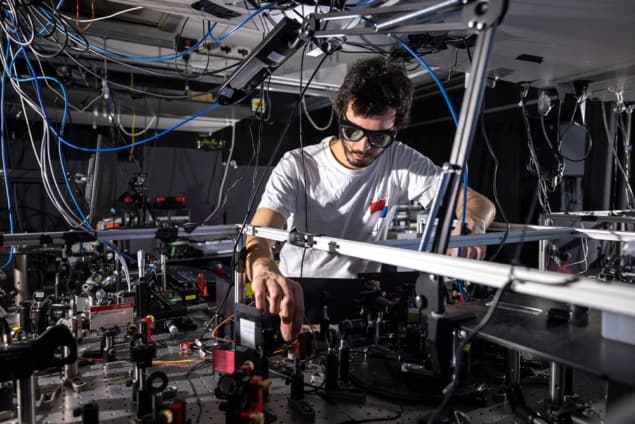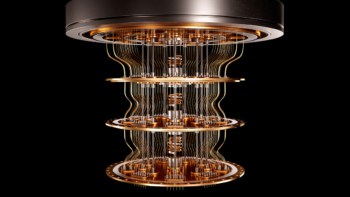
Thomas Young’s early nineteenth-century demonstration of interference between light waves sent through a pair of narrow slits is one of the most iconic experiments in the history of physics. But while that experiment and others like it involve diffraction of light in space, researchers in the UK and elsewhere have now shown it is possible to achieve the equivalent effect using double slits in time. They did so by turning the reflectivity of a semiconductor mirror on and off twice in quick succession and recording interference fringes along the frequency spectrum of light bounced off the mirror.
Young’s experiment involves directing light from a single, preferably monochromatic, source through two small apertures and measuring the resulting intensity pattern on a screen.
Diffraction from each slit causes the waves to spread out and interfere with one another, leading to constructive interference when the path difference is an integer number of wavelengths and destructive interference in the case of half-integer disparities. The result is a pattern of bright and dark stripes on the screen.
The demonstration provided fundamental support to the wave theory of light. Physicists have since gone on to carry out the same experiment with single photons, showing that even in that case interference fringes are formed (one photon at a time) – implying that light is both a wave and a particle. But until now no-one had demonstrated the temporal version of the experiment.
When a light wave impinges on a barrier containing two narrow slits separated in space, its frequency remains unaltered but its momentum changes as it diffracts outwards. This means that the distribution of the light’s electric field on the screen is roughly equal to the Fourier transform of the mathematical function that describes the shape of the slits in space.
In contrast, the temporal analogue involves fixed momentum but changing frequency. A material in which two slits rapidly appear and then disappear, one after the other, should cause incoming waves to maintain their path in space but spread out in frequency – so-called time diffraction. The frequency spectrum would be the Fourier transform of the function describing the slits in time, with interference between waves at different frequencies – rather than different spatial positions – generating the fringes.
Technological impact
Romain Tirole, Riccardo Sapienza and colleagues at Imperial College in London, together with researchers in the US and Germany, have observed such fringes by firing sets of three infrared laser pulses at a layer of indium tin oxide just 40 nm thick that is sandwiched between glass and gold. The two shortest pulses acted as the slits, each briefly transforming the layer from a transparent semiconductor to a reflective metal (reflection being easier to carry out than transmission). The third pulse instead acted as the probe, having its frequency spectrum broadened as it underwent the double reflection.
Measuring the spectrum of the reflected probe pulses, Tirole and co-workers found that the pulses’ initial bandwidth was stretched by about a factor of ten. Crucially, that spectrum contained a series of peaks that became progressively smaller further from the pulse’s central carrier frequency. What’s more, they found that those peaks got further apart the shorter the delay between the pump pulses.
The results, they say, are what would be expected of temporal diffraction. The peaks are the fringes generated by interference between light at different frequencies. And just as the fringes in a conventional double-slit experiment become more spread out in space when the slits are closer together, so too in this experiment they got further away in frequency terms when the slits were nearer to one another in time. Double slits with single atoms
While the size of the fringes closely matched theoretical predictions, their staying power came as a surprise – the peaks further from the central frequency being more pronounced than expected. This slow decay, the researchers say, indicates that the indium tin oxide responds more quickly to the leading edge of the slit pulses – taking less than 10 femtoseconds (10-14 s) to do so. This they point out is comparable with the length of one optical cycle of the infrared radiation they were using.
The researchers say that this finding calls for “a new fundamental understanding” of the response of such thinly layered materials. They believe that such “time-varying metamaterials” could have several applications, including very fast optical switches for signal processing and communication or reconfigurable components for optical computing.
Sapienza points out that such technology will require further work, given the impracticality of using very intense ultrafast laser pulses to create temporal double slits. But he adds that the phenomenon they have observed should also be a feature of other types of waves – such as radiofrequency, terahertz or acoustic – and that as such this novel type of diffraction should “impact many technologies”.
The research is published in Nature Physics.



